FC Girondins Bordeaux ended the season at the bottom of Ligue 1. A catastrophic campaign saw Bordeaux concede 91 goals in 38 games. A record that was equalled after 44 years, when Rouen conceded as many. Bordeaux’s games saw 143 goals across the season, a number that no team in the other top five leagues reached. While these games may have been entertaining for the neutral, Bordeaux fans were definitely not enjoying being pummelled week in and week out. On the other end of the pitch, Bordeaux were quite effective, scoring more goals than 10 of the other 19 teams, but ultimately, the poor defensive record was always going to cost them.
After 30 years in the top flight, a run only bettered by Paris Saint-Germain and Olympique Lyonnais, Bordeaux have been relegated from Ligue 1, and due to financial issues, have been further relegated to the third tier of French football. Although they made more money from sales, perhaps spending £8 million on players who aren’t definitely going to improve the team and aren’t guaranteed their spot wasn’t the wisest idea.
Vladimir Petkovic returned to club management after a seven-year stint as the Switzerland manager, but after 23 games in charge and stuck in the relegation zone, he was sacked in mid-February. David Guion was the man to replace him after a successful period at Reims, but the performances weren’t good enough to keep them up. This was a fall from grace for the club that was competing in the quarter-finals of the Champions League only 12 years ago.
This scout report will feature a tactical analysis of how David Guion set up Bordeaux during the back end of the season. It will also feature an analysis of how these tactics changed from the previous manager, whilst still having the same result of scoring and conceding more goals than anyone else.
Formation
A large problem Bordeaux had, was the lack of consistency in the team from week to week. As shown in the image below, the most common system for Bordeaux under Petkovic was the 4-4-2, which was only used 12% of the time translating to playing that system for 5 games in the 23 games he managed. When the new manager came, he brought some stability using either a 3-4-3 or 3-4-1-2 in 13 of the 14 games he was in charge of. This stability and consistency allowed Bordeaux to slightly improve performances, although they still endured some heavy defeats in that period.
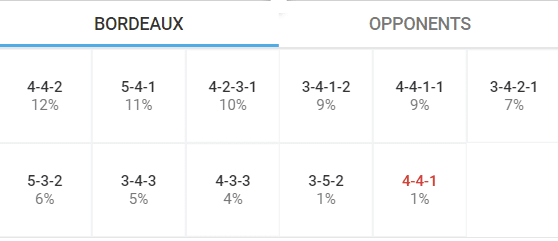
Furthermore, only three players had over 25 starts in the league. This shows that the best starting team was unknown and the players were always trying to figure out how each other plays, with unfamiliar partnerships across the team.
Changing formations and personnel so often prevents players from building chemistry together and slows down the ability of players to make themselves familiar with the style of play. This lack of decisiveness in picking a team and sticking to it can definitely be listed as a reason for the poor performances across the season.
In Possession
Build Up
During the first half of the season, Bordeaux were less brave, with more outlets positioned higher up the pitch. It was harder to play out from the back due to the limited numbers in build-up, which forced them to play longer passes which weren’t regularly successful. When Guion came in, he had a clear plan to use a three-man defence as well as a midfield pivot. The midfield pairing consisted of one player who would stay deep to help retain the ball whilst the other roamed slightly further forward to offer vertical progression through central areas. The two wing-backs held their position out wide, to stretch the pitch and allow for a pass to feet should the central players be struggling under pressure.
Bordeaux were encouraged to try to play out from the back and had the players in positions that enabled them to play out with regular success. The three players further up acted as outlets to allow for long balls, but the overload in the first phase meant Bordeaux were able to keep more possession of the ball.
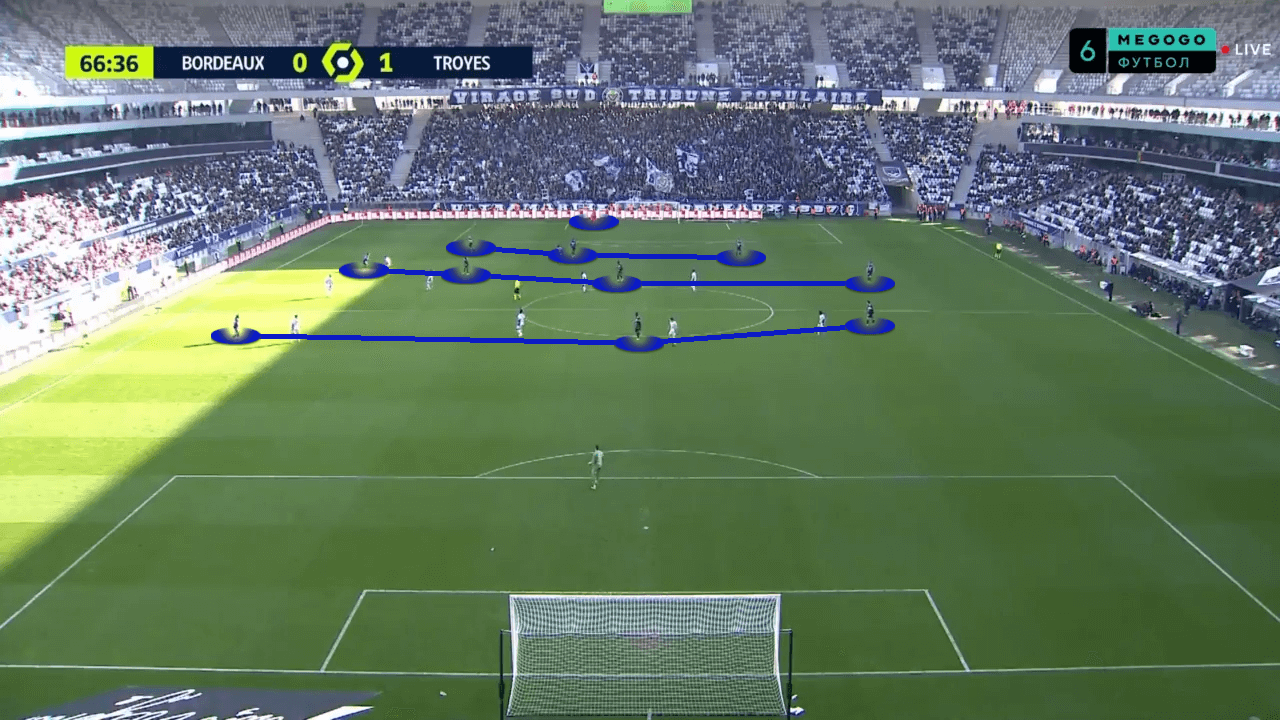
At times, Bordeaux would be matched up for numbers when attempting to build play. In those situations, as shown below, Yacine Adli would drop in from the front three to form a 3 man midfield. The use of his intelligence and quality on the ball helped make progression through the thirds easier for the team, although the defensive players were not always willing to take the risk.
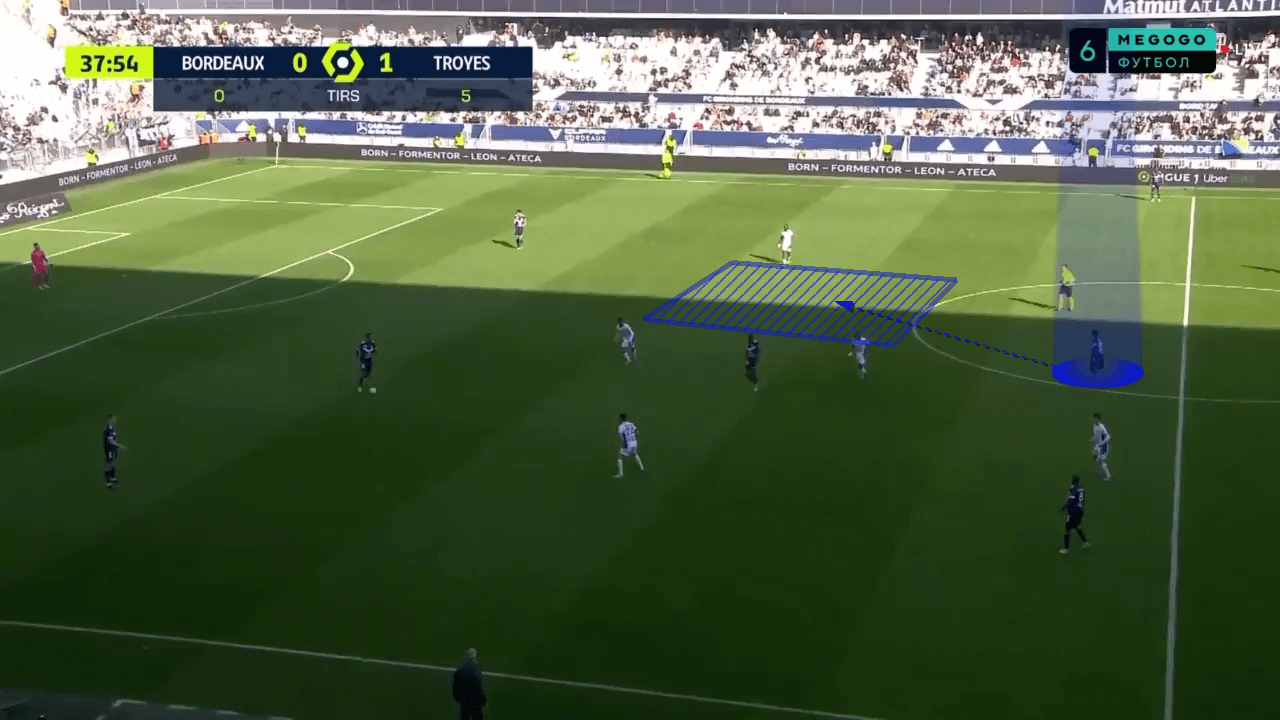
Chance Creation
Bordeaux scored 52 goals in the league, which left them placed tenth in the league for goals. This was an area in which they showed competence and were rather enjoyable to watch.
Off-the-ball runs from deeper players were something that Guion introduced into the team and it worked quite well. Whilst defensive players were preoccupied with the Bordeaux front line, a deep run from a central midfielder would be made into a wide channel. This run was usually tough to mark due to the long distance being covered, and the defensive player having to chase after the runner, rather than them already being in a low block with the attacker running at them. This third-man run idea allowed the player to receive the ball on the edge of the box, unmarked, as shown in the image below. Although a goal wasn’t scored off the back of this, it was one of the better chances Bordeaux managed to create against a stubborn defence.
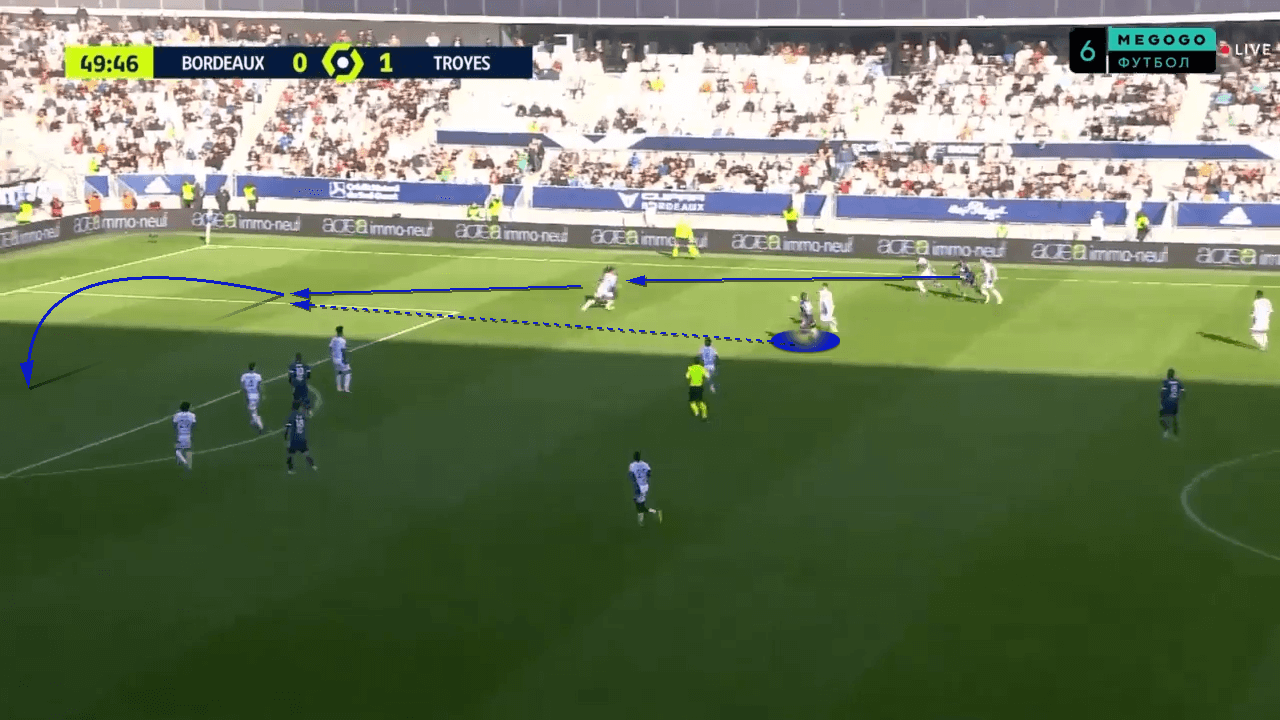
Bordeaux also had achieved success by keeping the ball in wide areas before crossing it in. When Guion came in and implemented the back five, it meant they would attack the box with a front five. This would be particularly effective against a back four where five runners would attack the box, and often one player would be left unmarked. This was usually the far wing-back who was making a slightly later run, so the cross to the back post was always on. This image below demonstrates Bordeaux’s ability to deliver balls towards the back post. A particular target was to aim towards the back post, where an attacker would be in the defenders’ blind side, allowing the attacker to gain space in the box without being tightly marked and scoring the header.
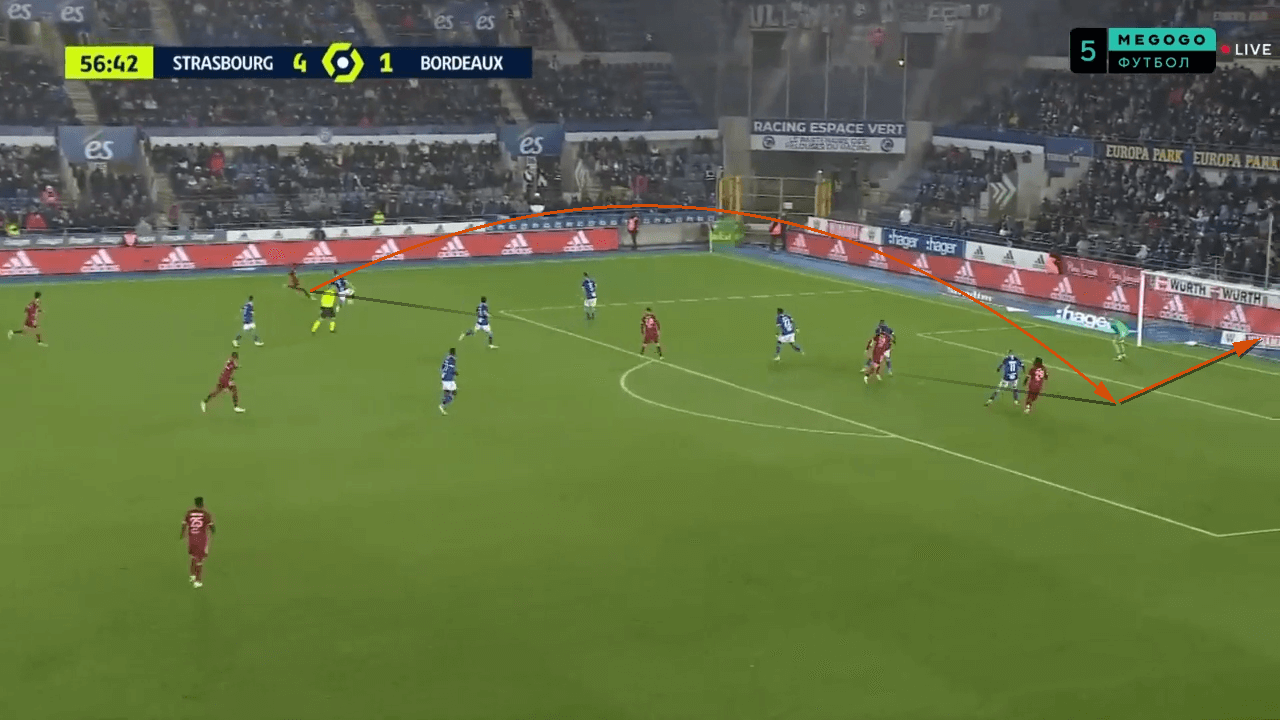
A low block is not something that Bordeaux always came up against. A lot of the success Bordeaux had was from direct counterattacks where passes could be made into space in behind for the attackers to run onto a pass and be 1v1 with the goalkeeper.
Out of Possession
Pressing
When out of possession, Bordeaux did not always press high. They would mainly do so during dead-ball situations when players had time to get close to their opponent. In these situations, the ball can’t be manipulated through dribbling as the keeper has to make contact with the ball, and so it was easier for Bordeaux to press high. This image below shows how they matched up man to man to force the opposition to boot the ball over a longer distance, reducing the chance of keeping possession of the ball. In settled play, Bordeaux would attempt to sit deeper and block the space available rather than trying to win the ball back instantly.
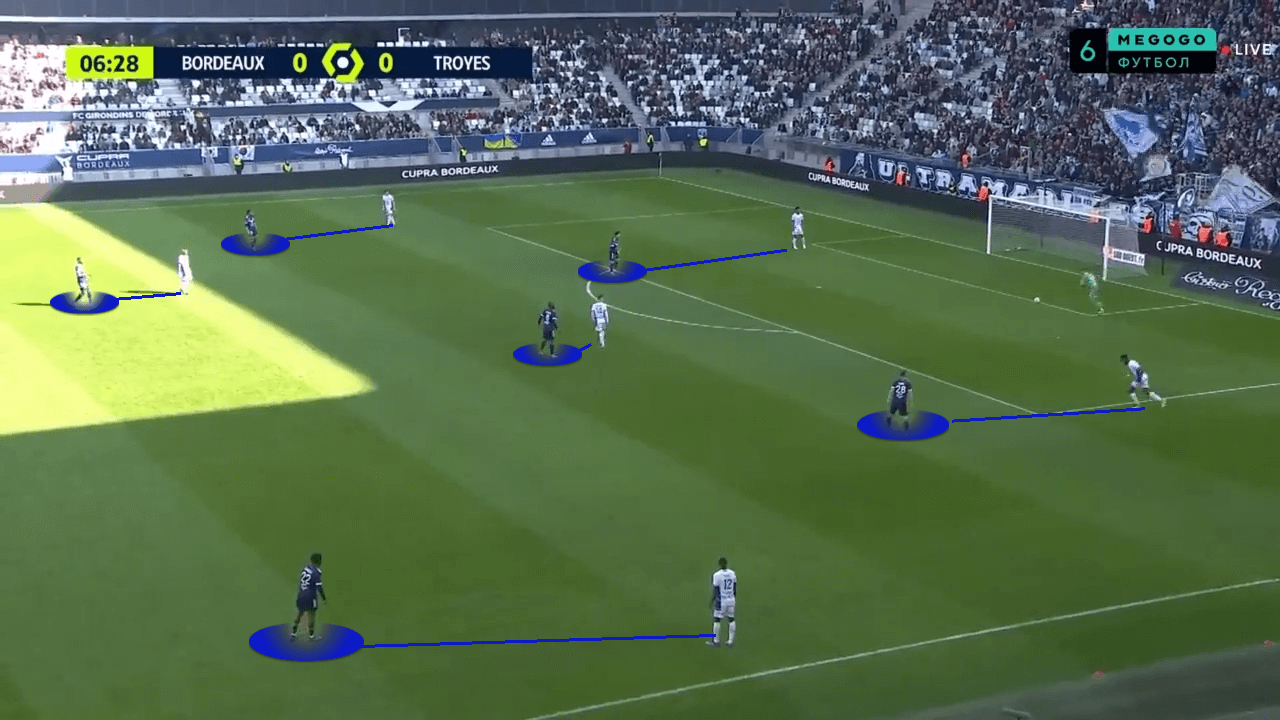
With the addition of the back five, Guion encouraged his wide centre backs to jump out of position and defend on the front foot. The back five allows for the central defender to attempt to win the ball back, and still have adequate cover behind if they do make a mistake. This move has recently been showcased through teams like Chelsea, where Antonio Rudiger rushes out to prevent opposition attackers from receiving the ball.
This move discourages opponents from attempting those passes again, which means that the ball is kept away from the goal. The image below shows how the Bordeaux defender meets the attacker with his back to goal, making it tough for him to turn towards the goal and he is forced to turn back, and in this example, the defender intercepts the pass and helps Bordeaux begin a counterattack.
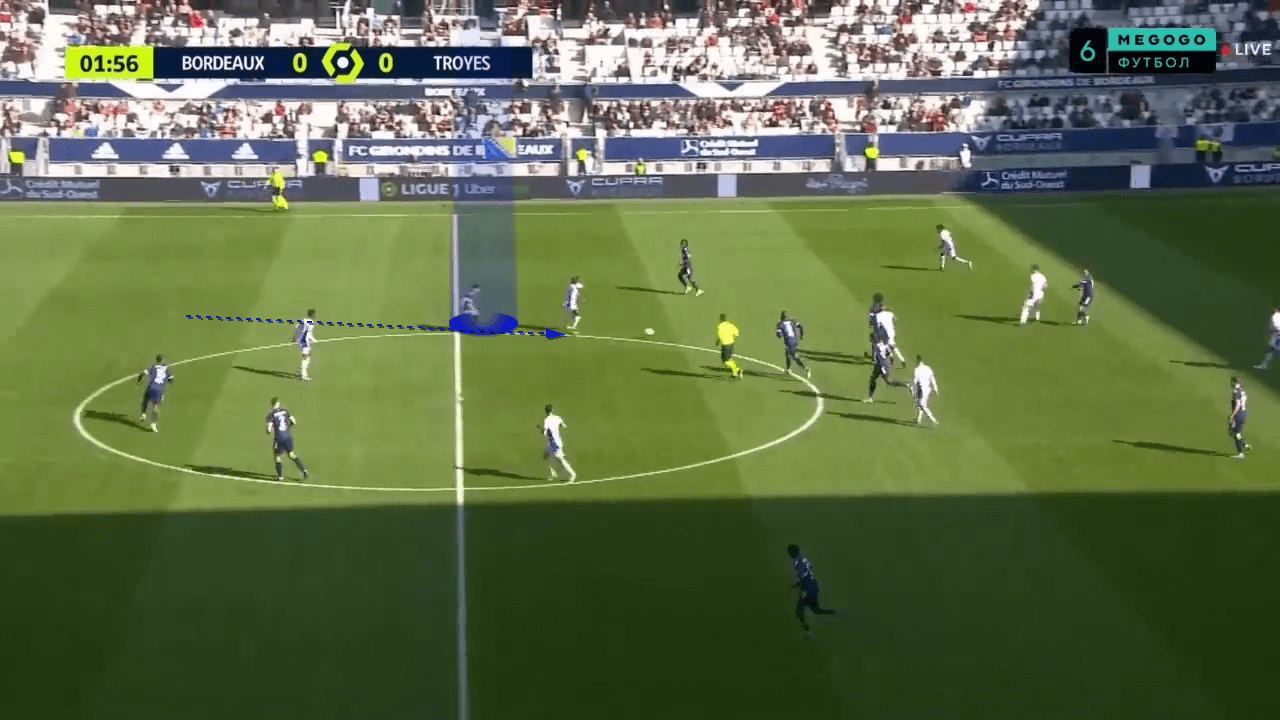
Whilst this tactic helps reduce the number of attacks Bordeaux deal with, encouraging these players to perform the move while they are not at the required level may create more problems than it solves. The image below shows how the defender misjudged the pace of the pass as he thought he could intercept it but was caught in no man’s land. The space he left was attacked and the player on the ball has time to play the pass as the centre-back is still rushing out. This led to a dangerous opportunity, and while the manager’s bravery to implement this can be appreciated, the team doesn’t possess the quality to defend on the front foot and this mistake occurred too many times and gifted opponents too many easy chances.
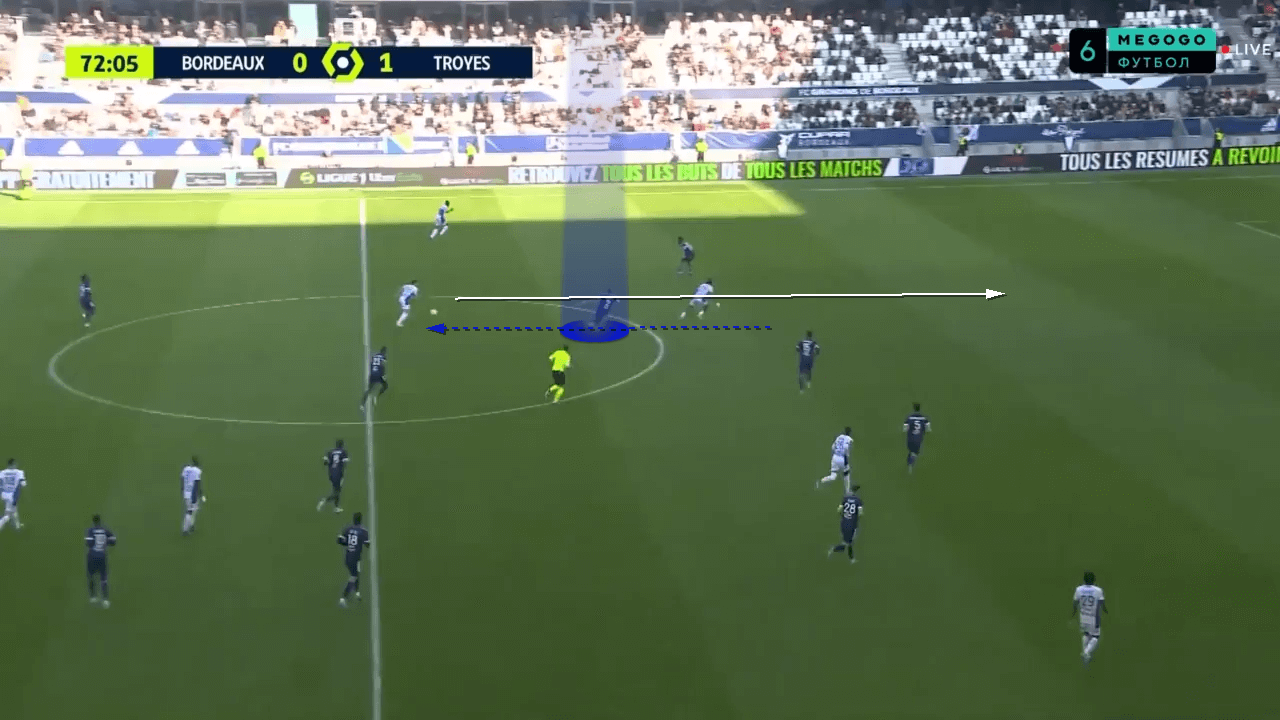
Chance Prevention
When sitting in deep blocks, Bordeaux have been good at keeping a compact shape and not letting opponents keep the ball between the lines. However, at times the midfield line has been too slow to cover ground horizontally, and this has led to incidents like the one pictured below, where players are not covering all the right spaces. No player should be able to receive the ball 25 yards from goal and have enough time to set themselves up and shoot at goal. The poor positioning of the players means they can’t get to the ball in time and have allowed a dangerous shot to come at the goalkeeper.
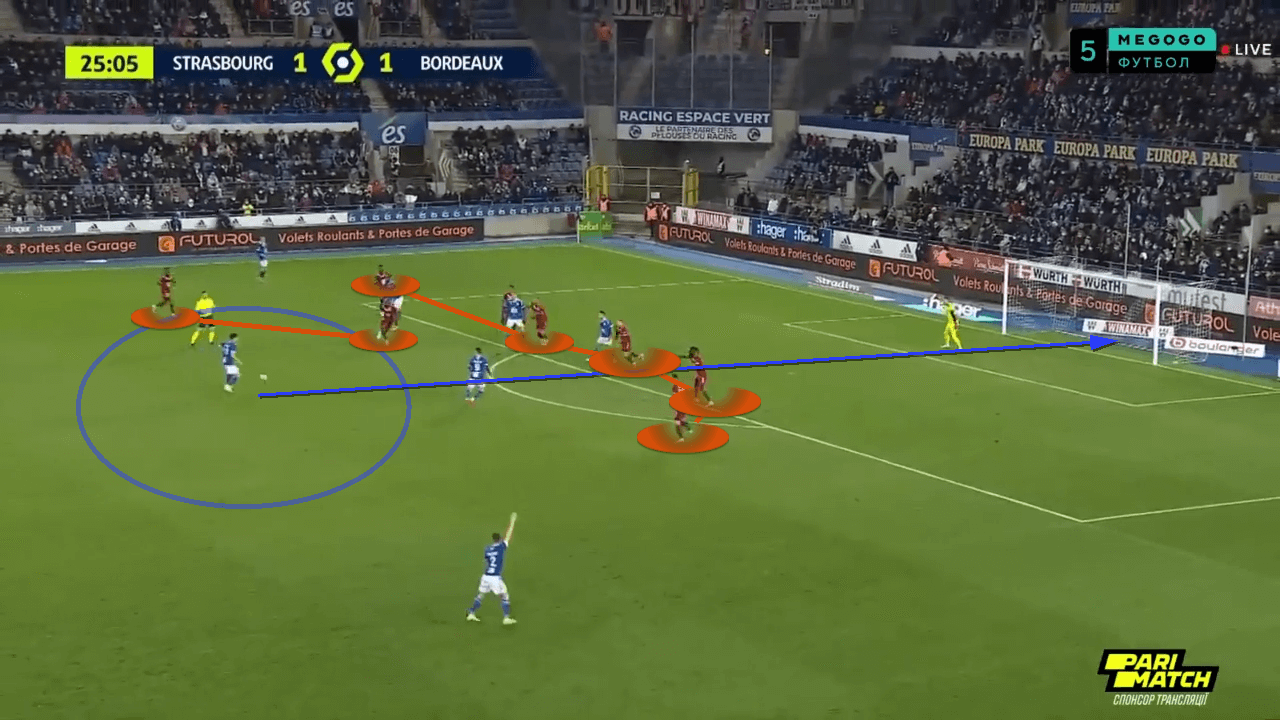
Another reason as to why Bordeaux conceded so many goals was down to a lack of recovery runs being made from the forward players. It is also the job of attackers to help prevent the opposition from scoring, and the lack of a willingness to want to do that has cost Bordeaux on a number of occasions.
The image below clearly shows how an opposition attacker has been left open, and no one within ten yards of him in such a dangerous position. The winger is seen entering the frame, realising he should be marking the opponent but it’s too late and the Strasbourg attacker has lots of space to attack the ball.
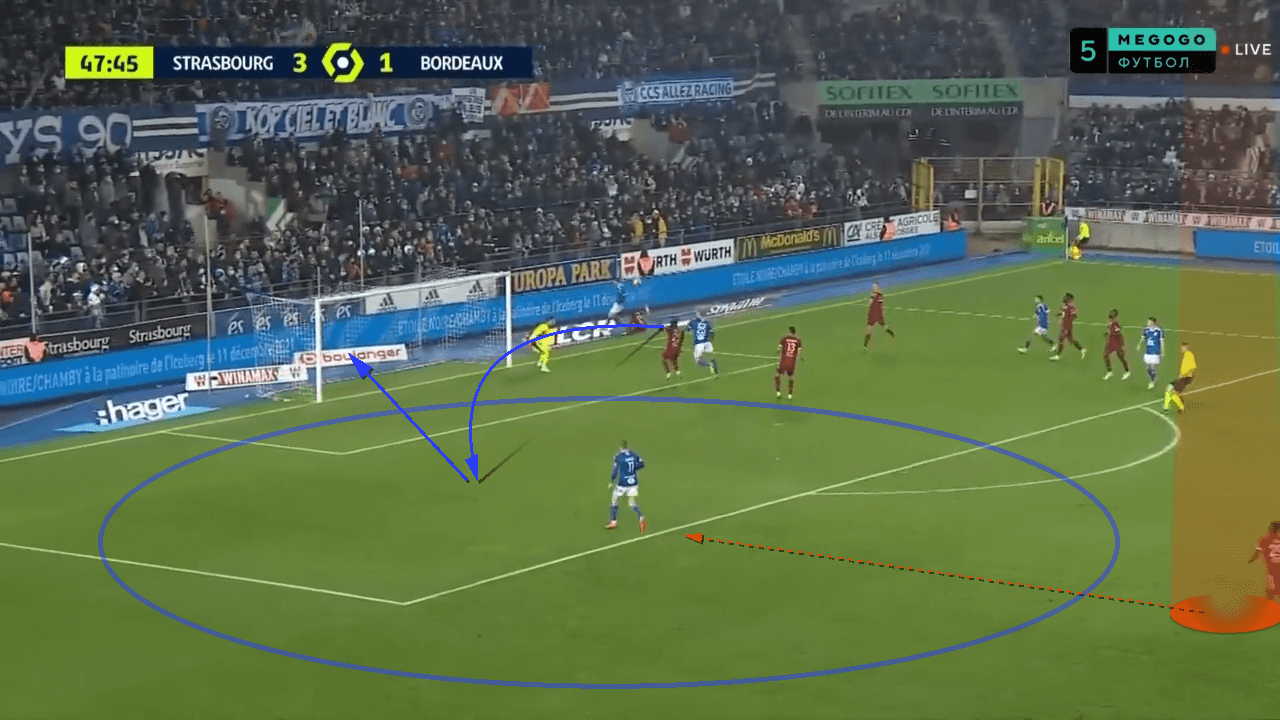
Another couple of problems that Bordeaux have had include being too slow to collect second balls from headers being knocked down, and the lack of aggression when closing down players in dangerous positions. These are poor fundamentals of a lack of awareness and desire to want to prevent the opposition from scoring rather than huge tactical flaws which have ultimately cost Bordeaux their place in the league.
Transition
Attacking Transition
Bordeaux have been strong in attacking transitions. Strong and powerful runs from deep help carry the ball up the pitch when possession is regained. These runs eliminate opposition midfielders out of the game, leaving 2 Bordeaux players to attack the space behind the opposition defence, where the attacking full-backs have left their positions. The image below shows this happening, whilst the central player drops deep to receive the ball in a higher position and turns with the ball before playing the pass. For most, it is easier to complete a 20-yard pass than a 40-yard pass and so the ball is played to the furthest player centrally before the killer pass is attempted.
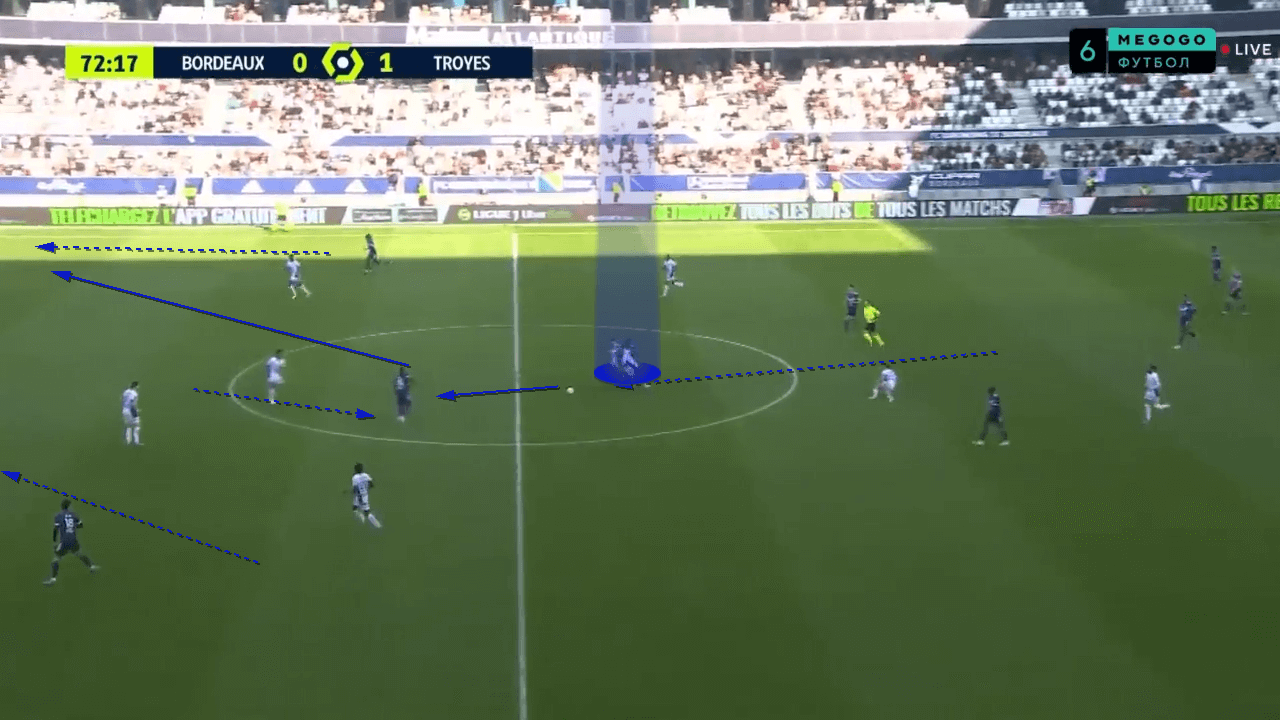
Defensive Transition
When Bordeaux lose the ball, they attempt to limit the space that attackers can run into, rather than preventing the pass from being made by the deeper players. The decision to regroup rather than counter-press is one that probably cost Bordeaux to concede goals in transition where other teams would intercept the ball before the play even looks dangerous.
The image below shows how the defender is running back to goal, although he clearly has adequate cover, and is close enough to the ball to intercept it before the striker receives it. Allowing the striker to turn and run at pace leaves the Bordeaux back line vulnerable and prone to conceding a high-value chance.
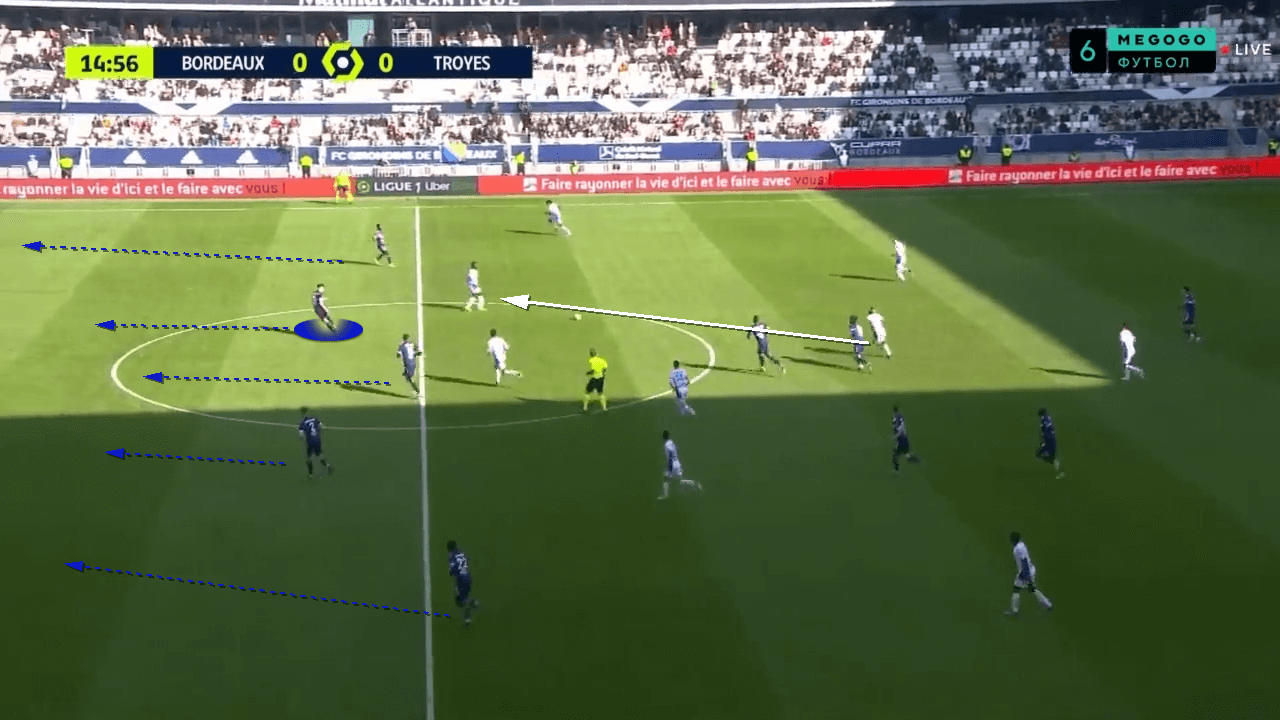
The image below shows yet another example of players simply getting back into position rather than trying to disrupt play before it even gets started. The players who pass the ball between each other have plenty of space, which allows them to easily complete a pass while the Bordeaux players beside them are just trying to get back into shape. It is up to the manager to motivate them and encourage them to increase their aggression towards the ball when the back line is in such a vulnerable state.
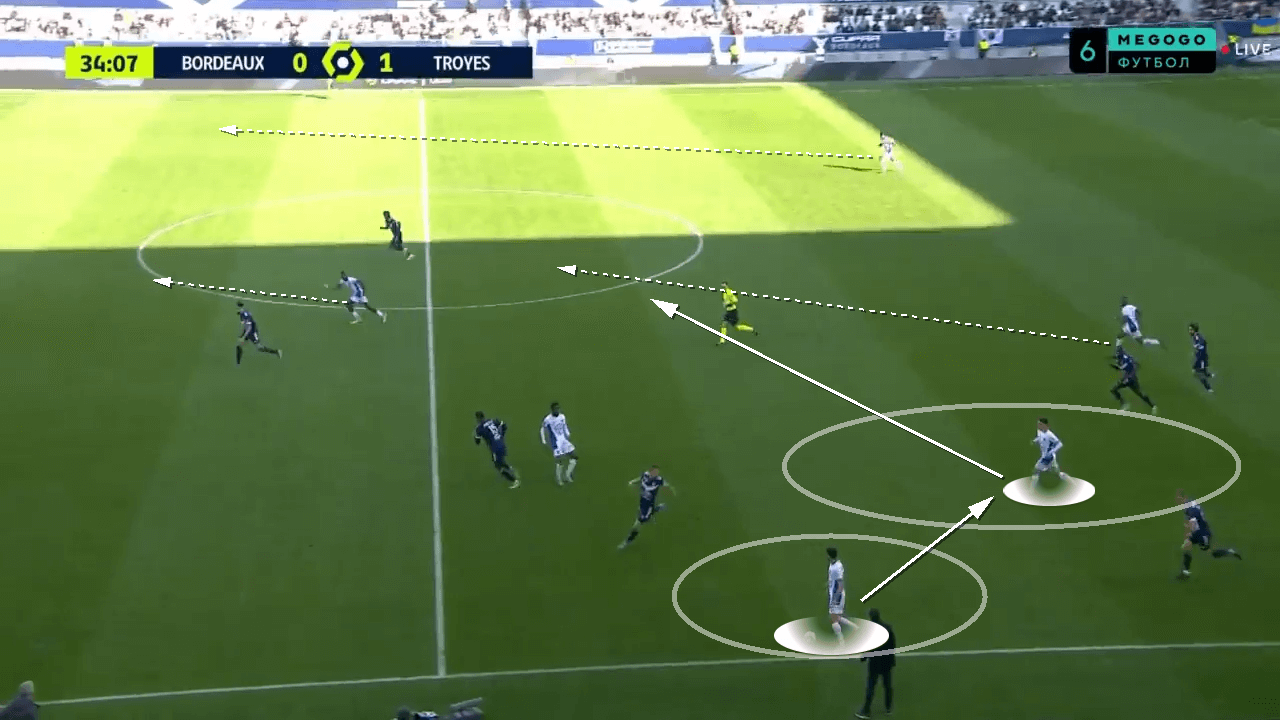
Conclusion
In conclusion, Bordeaux have demonstrated their ability to create goalscoring chances at the highest level in French football, but the inability to tactically prevent the opposition from having all the time they want to create chances has cost them in the battle to survive the drop. A combination of lazy, unaggressive defending, poor judgement and a woeful tactical set-up have ended up costing Bordeaux their place at the top tier of French football, and it will take some time before they return, especially if they defend the way they have done this season.






Comments